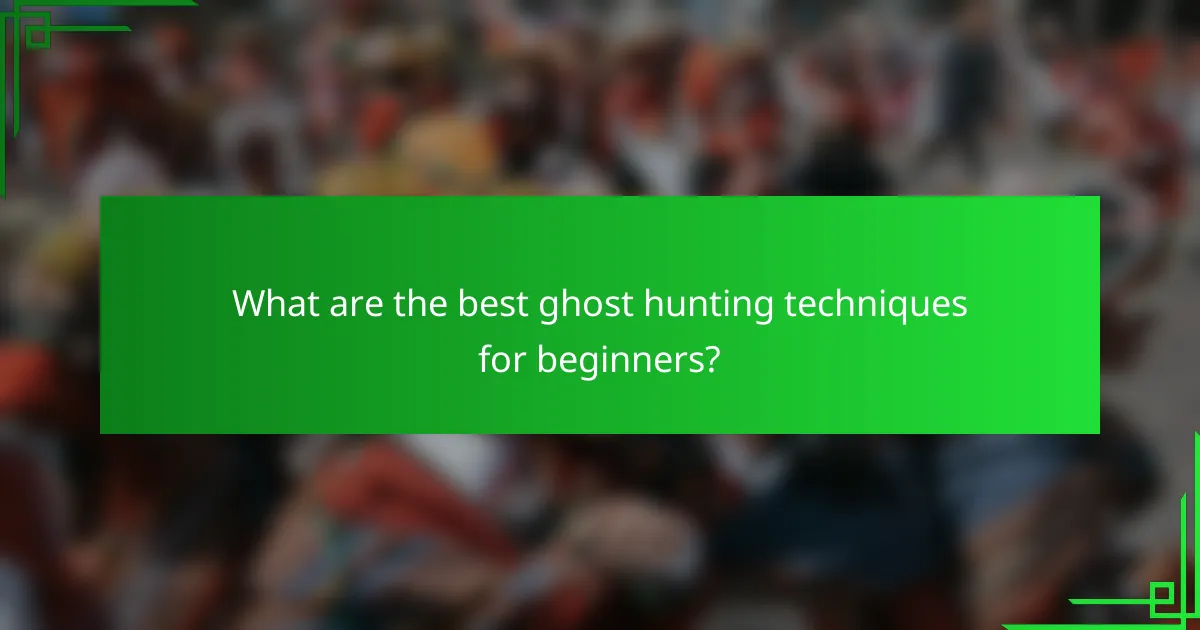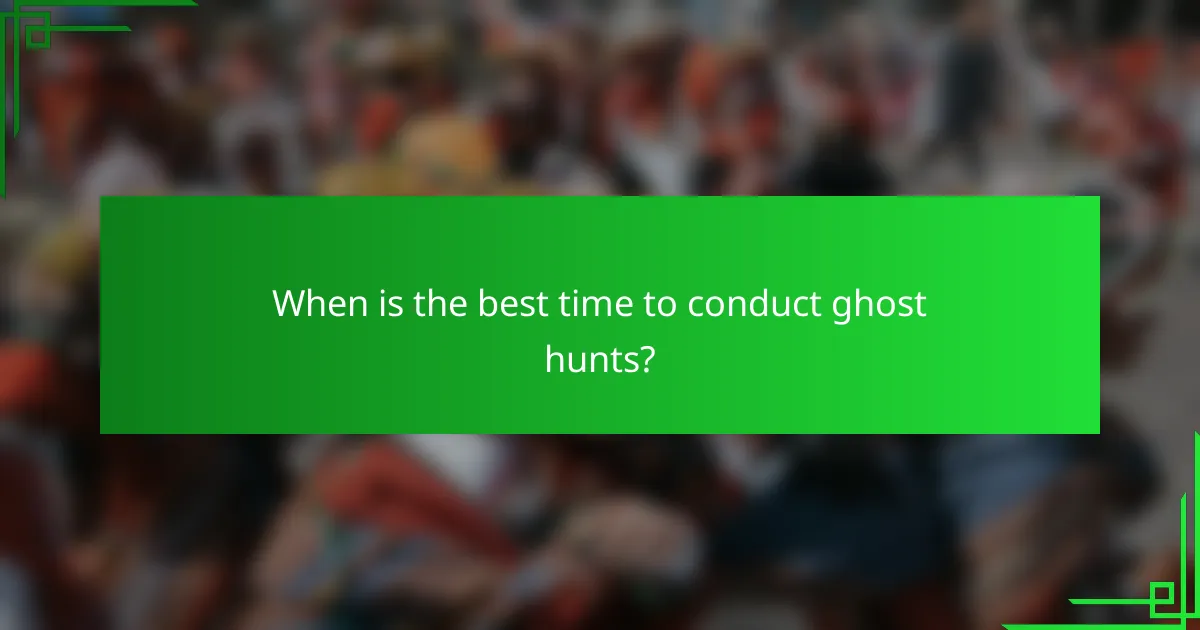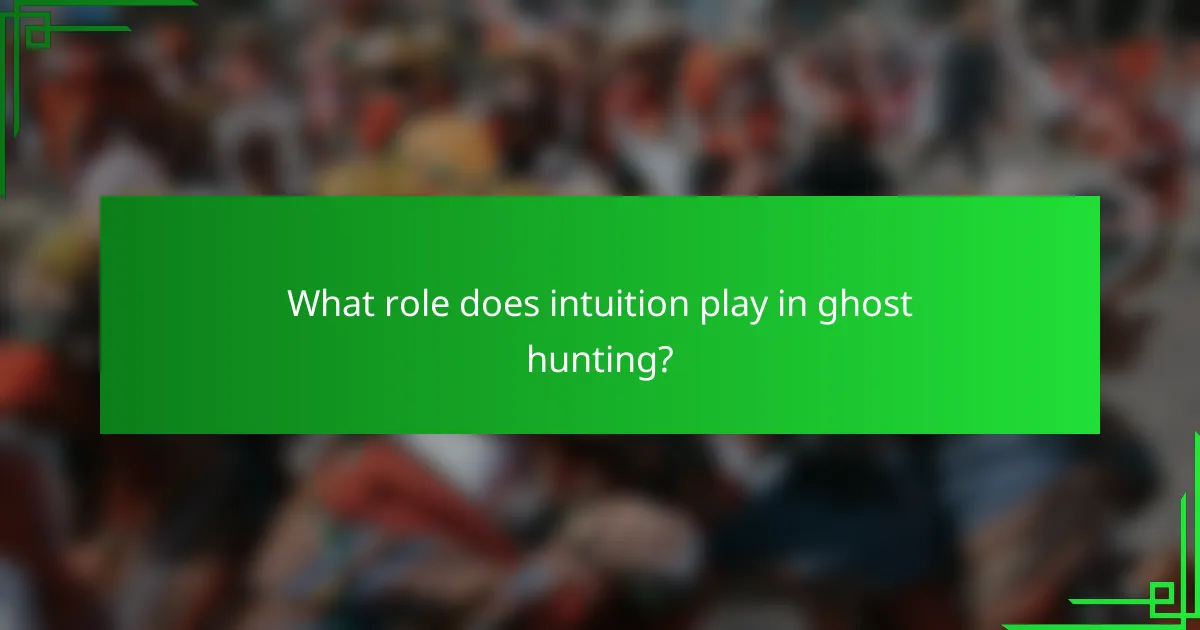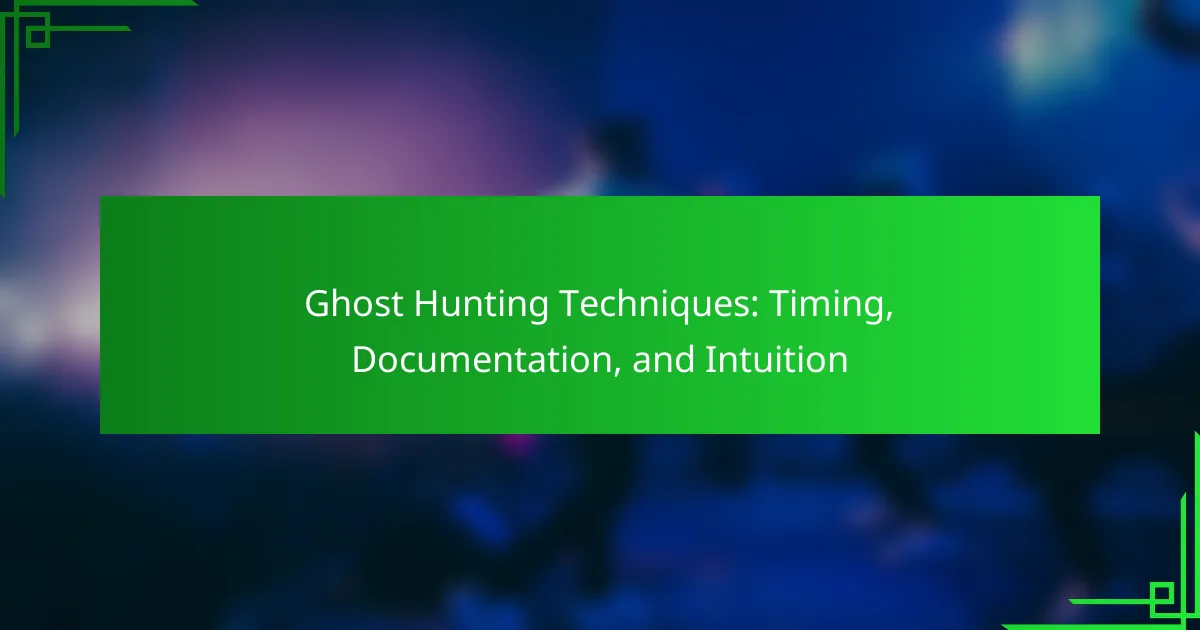Ghost hunting combines various techniques to explore potential paranormal activity, with methods such as EVP sessions, spirit box communication, and EMF meter readings playing crucial roles. Timing is essential, as nighttime and specific lunar phases can heighten the chances of encounters. Thorough documentation of experiences and findings is vital for analysis and credibility, ensuring that each investigation is both systematic and insightful.

What are the best ghost hunting techniques for beginners?
For beginners in ghost hunting, effective techniques include Electronic Voice Phenomena (EVP) sessions, spirit box communication, using infrared cameras, EMF meter readings, and physical mediumship. Each method offers unique insights into potential paranormal activity and can enhance the overall investigation experience.
Electronic Voice Phenomena (EVP) sessions
EVP sessions involve using audio recording devices to capture unexplained sounds or voices. To conduct a successful EVP session, choose a quiet location, ask clear questions, and allow pauses for potential responses. Review the recordings later for any anomalies that may indicate spirit communication.
Common pitfalls include background noise interference and not allowing enough silence for responses. Using high-quality recording equipment can improve results, and it’s advisable to keep the session duration between 20 to 30 minutes to maintain focus.
Spirit box communication
A spirit box is a device that scans radio frequencies to facilitate communication with spirits. During a session, ask questions and listen for coherent responses that may come through the static. It’s essential to remain calm and open-minded, as responses can be subtle and require careful interpretation.
When using a spirit box, avoid overly complex questions and focus on simple, direct inquiries. Sessions should ideally last around 15 to 20 minutes to prevent fatigue and maintain clarity in communication.
Using infrared cameras
Infrared cameras are useful for detecting temperature changes and capturing visual anomalies in low-light conditions. These cameras can reveal unexplained heat signatures or movement that may suggest paranormal activity. Position the camera in areas of interest and monitor it for extended periods.
Ensure your camera is set to the appropriate sensitivity and check for any potential obstructions that could interfere with the view. Regularly review footage for any unusual occurrences, as some phenomena may only be visible upon playback.
EMF meter readings
EMF meters measure electromagnetic fields, which some believe can indicate the presence of spirits. To use an EMF meter, walk around the investigation site and take note of any spikes in readings, particularly in areas with reported paranormal activity. Consistent readings above baseline levels may warrant further investigation.
Be aware of common sources of electromagnetic interference, such as electrical wiring and appliances, which can skew results. It’s advisable to establish a baseline reading in a known non-active area before beginning your investigation.
Physical mediumship
Physical mediumship involves a person acting as a conduit for spirit communication, often resulting in physical manifestations such as movement of objects or changes in the environment. To explore this technique, find a reputable medium and participate in a controlled session, ensuring a respectful atmosphere.
Approach physical mediumship with an open mind but also a healthy skepticism. Document any occurrences meticulously, as this can help validate experiences and provide insights into the nature of the phenomena observed.

When is the best time to conduct ghost hunts?
The best time to conduct ghost hunts is typically during nighttime hours when ambient noise is lower and darkness enhances the atmosphere. Additionally, certain seasons and moon phases can influence paranormal activity, making timing a crucial factor in the success of investigations.
Nighttime investigations
Nighttime is often preferred for ghost hunting due to reduced distractions and increased eeriness. Many believe that spirits are more active after dark, making it easier to capture evidence. Investigators should aim to start their sessions late in the evening, ideally after 10 PM, when most disturbances from daily life have subsided.
However, it’s essential to remain cautious; ensure that all equipment is functional and that team members are aware of their surroundings to avoid accidents in the dark. Using flashlights with red filters can help maintain night vision while still allowing for visibility.
Seasonal considerations
Different seasons can affect ghost hunting experiences, with fall and winter often being more popular due to the association with Halloween and colder weather. Many believe that spirits are more active during these times, as the atmosphere feels more conducive to paranormal activity.
Spring and summer can also yield interesting results, particularly in locations with rich histories or folklore. Investigators should consider local events or festivals that may attract visitors and potentially stir up activity, but be mindful of increased foot traffic that could interfere with the investigation.
Moon phases and their effects
The moon’s phases can influence ghost hunting outcomes, with many investigators preferring to conduct sessions during the new moon or waxing phases. These times are thought to enhance spiritual energy and visibility, making it easier to capture evidence.
Conversely, full moons can create bright conditions that may hinder visibility and alter the atmosphere, potentially scaring away spirits. It’s beneficial to plan investigations around these lunar cycles, keeping a lunar calendar handy for reference.

How to document ghost hunting experiences effectively?
Documenting ghost hunting experiences involves capturing evidence through various methods, ensuring that all findings are recorded accurately for analysis. Effective documentation enhances the credibility of your findings and allows for better review and comparison over time.
Video recording techniques
Video recording is a powerful tool in ghost hunting, as it captures visual evidence that can be reviewed later. Use high-definition cameras with night vision capabilities to ensure clarity in low-light conditions, which are often present during investigations.
When filming, keep the camera steady and avoid sudden movements to maintain focus on potential paranormal activity. It’s beneficial to use a tripod and to record continuously for extended periods, as significant events may occur unexpectedly.
Audio documentation methods
Audio documentation is essential for capturing EVPs (Electronic Voice Phenomena) and other sounds that may indicate paranormal activity. Use high-quality digital voice recorders with a good frequency response to ensure clear sound capture.
Position the recorder in areas of interest and allow it to run for a significant duration, ideally during quiet periods. After recording, listen carefully for any unexplained voices or noises, and consider using audio editing software to enhance sound clarity for analysis.
Field notes and journals
Maintaining detailed field notes and journals is crucial for documenting ghost hunting experiences. Record observations, environmental conditions, and personal feelings during the investigation, as these can provide context for any findings.
Use a consistent format for your notes, including date, time, location, and specific events. This practice helps in identifying patterns over time and can be invaluable when comparing different investigations or locations.

What role does intuition play in ghost hunting?
Intuition plays a significant role in ghost hunting by guiding investigators in sensing the presence of spirits and interpreting their surroundings. Many ghost hunters rely on their instincts to identify unusual occurrences and make decisions during investigations.
Trusting gut feelings
Trusting gut feelings is essential in ghost hunting, as these instincts can often signal the presence of paranormal activity. When you feel an inexplicable chill or a sudden sense of unease, it may be worth investigating further. Keeping a journal of these feelings can help you identify patterns over time.
However, it’s important to differentiate between genuine intuition and anxiety or fear. Practice mindfulness to enhance your awareness and discernment during investigations.
Recognizing environmental changes
Environmental changes can provide crucial clues during ghost hunts. Sudden drops in temperature, flickering lights, or unexplained sounds may indicate the presence of a spirit. Being attuned to these shifts can help you respond appropriately and capture evidence of paranormal activity.
To effectively recognize these changes, maintain a baseline understanding of the location’s normal conditions. This can involve noting typical temperature ranges or common sounds in the area, allowing you to detect anomalies more easily.
Developing psychic sensitivity
Developing psychic sensitivity can enhance your ghost hunting skills by allowing you to perceive energies and entities that others may miss. Techniques such as meditation, visualization, and grounding exercises can help sharpen your intuitive abilities. Regular practice can lead to increased awareness during investigations.
Consider joining workshops or groups focused on psychic development to learn from experienced practitioners. Engaging with others can provide valuable insights and help you refine your skills in a supportive environment.

What equipment is essential for ghost hunting?
Essential ghost hunting equipment includes tools that help capture evidence of paranormal activity, such as visual and thermal imaging devices, as well as communication tools. These instruments enhance the investigation by providing various ways to detect and document potential ghostly encounters.
Digital cameras
Digital cameras are crucial for capturing visual evidence during ghost hunts. High-resolution cameras with low-light capabilities are preferred, as they can document anomalies in dimly lit environments. Consider using models that allow for manual settings to adjust exposure and focus for optimal results.
When using digital cameras, be aware of common pitfalls such as lens flare and motion blur. To mitigate these issues, use a tripod for stability and take multiple shots of the same area to increase the chances of capturing something unusual.
Thermal imaging devices
Thermal imaging devices detect heat signatures, making them valuable for identifying cold spots or unexplained temperature variations often associated with paranormal activity. These devices can reveal entities that may not be visible to the naked eye, as they highlight differences in temperature.
When selecting a thermal imaging device, look for one with a good resolution and sensitivity to temperature changes. Keep in mind that environmental factors, like drafts or electrical appliances, can affect readings, so it’s important to familiarize yourself with the area before drawing conclusions.
Spirit communication tools
Spirit communication tools, such as EVP (Electronic Voice Phenomena) recorders and spirit boxes, are designed to facilitate interaction with potential spirits. EVP recorders capture audio that may include voices or sounds not heard during the investigation, while spirit boxes scan radio frequencies to create real-time communication opportunities.
To effectively use these tools, ensure you have a quiet environment to minimize background noise. When reviewing recordings, listen carefully for anomalies and consider using headphones for better clarity. Always approach findings with a critical mindset, as many sounds can have natural explanations.
